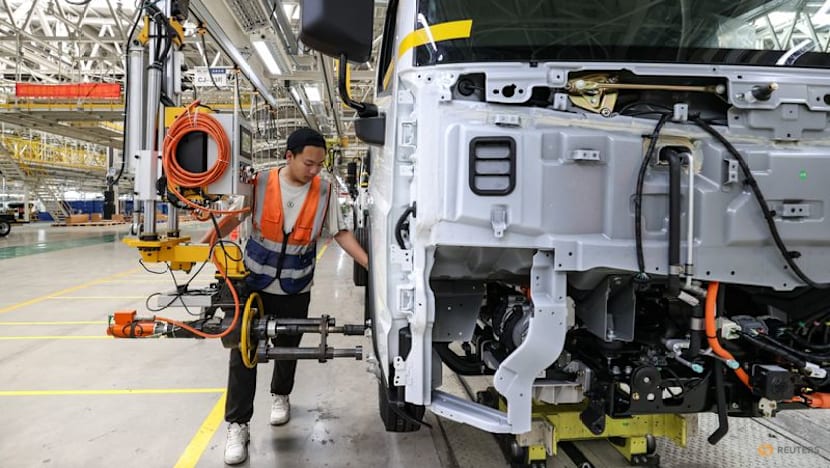Commentary: Elon Musk and Bill Gates were both wrong on the future of trucks
Sales of electrified rigs are booming in China, with the United States lagging far behind, says David Fickling for Bloomberg Opinion.

An employee works on a production line manufacturing electric trucks at a factory in Gui'an New Area, Guizhou province, China Jul 2, 2025. cnsphoto via REUTERS
SYDNEY: To hear Bill Gates tell it, the electric drivetrains that have transformed the passenger vehicle industry over the past decade have no chance of repeating the trick in heavy trucks. According to Elon Musk, such a transition is inevitable – and Tesla will be leading it.
Both of them are wrong.
EV trucks really are on the brink of taking over – but Tesla is barely in the game. Only around 50,000 units of its monstrous cubist pickup, the Cybertruck, have been sold so far. The Semi tractor trailer is still essentially a demonstration model, eight years after it was first announced.
Instead, it’s China which is again at the cutting edge, with Europe’s Volvo, Daimler Truck and Iveco running quite a way behind. America’s hopes of playing a role are looking increasingly threadbare.
The magnitude of the sales boom in China over the past 12 months has been breathtaking. In September 2020, when Musk was beefing with Gates on Twitter about his truck-scepticism, just a few dozen battery-powered semi-trailers had ever been sold there. In 2024, 79,142 medium and heavy trucks were sold, according to BloombergNEF. A further 81,508 changed hands in the first half of this year alone.
Sales of electric heavy trucks in August nearly tripled from a year earlier, according to First Commercial Vehicle Network, a local freight information service, giving them a share of about 26 per cent in their segment. Some 29 per cent of medium-sized trucks sold in China in August were plug-in variants, the China Automotive Technology and Research Center found, plus 22 per cent of light ones.
Contemporary Amperex Technology, the biggest battery maker, reckons heavy trucks will be 50 per cent electrified by 2028, while Sany Heavy Industry thinks the figure could go as high as 80 per cent.
DOWNWARD PRESSURE ON DEMAND FOR CRUDE
The implications of this go far beyond China’s own borders. Because of the long distances they drive and the vast loads they carry, heavy trucks are disproportionately polluting, burning half of China’s road fuel despite making up only 15 per cent of vehicles. About 3.6 per cent of the world’s oil is consumed as diesel in China. Most goes into the same trucks that are electrifying at dizzying speed.
That’s going to rapidly start putting downward pressure on demand for crude. Rhodium Group, a consultancy, reckons electrified cars and trucks in China alone are going to be destroying about 1.76 million barrels a day of demand next year, equivalent to about one in 45 barrels of crude produced.
The supposed challenges of electrifying energy-hungry heavy trucks have been crucial to expectations that petroleum consumption will hold up in the years ahead, even as EVs sap usage by cars. A 2017 report by the International Energy Agency on the future of freight excluded plug-in long-haul trucks from its price analysis altogether, since it considered the technology too implausible to be worth modelling. This year’s sales figures blow those complacent assumptions out of the water.
What’s changed? Stricter fuel-economy regulations which went into effect in China Jul 1 are part of the explanation. So, too, is the realisation that most trucks are used inefficiently, allowing electrified variants to bite off large slices of the market that aren’t carrying the very heaviest loads the longest distances. But the biggest factor is simply economics.
Trucking is a low-margin industry where running costs are everything. If a technology can save you a few yuan, you’ll be unsentimental about adopting it. That’s why a brief boom in natural-gas powered trucks, which appeared to be taking over China’s logistics industry last year, is already fading. With battery prices now falling as low as US$90 per kilowatt hour, according to BloombergNEF, the value proposition of electric rigs is simply superior.
The sticker price of a plug-in semi-trailer is still significantly higher, but operators can more than make up the difference thanks to cheaper fuelling, maintenance and insurance expenses. Once the cost of a long-haul electric truck falls to about US$250,000 – something BloombergNEF sees happening around 2030 – then the zero-emission option will be cheaper wherever you pay more for a litre of diesel than for about four kilowatt-hours of electricity.
WINTER IS COMING FOR OIL PRODUCERS
China is dominating this industry right now, and it’s likely to be a formidable competitor in the future as Sany Heavy and XCMG Construction Machinery focus more and more on export markets.
Europe, however, is no slouch. It exceeds America in terms of the share of freight that’s moved by road, and its manufacturers already account for more than half of heavy truck sales in the US – likely one reason behind President Donald Trump’s announcement of a 25 per cent tariff on imports on Thursday (Sep 25).
Volvo sold its 5,000th electric truck in April. In May, it unveiled a semi-trailer with a 600km range, capable of carrying a 48-tonne load and charging in the time it takes for drivers to take mandatory rest breaks. That should be more than capable of competing with the conventional long-haul freight market.
Fossil fuel bulls can draw fanciful projections of a bright future, but in the real world crude demand is still struggling to hit the levels it reached in 2018.
One after another, the supposed bulwarks of future growth – emerging markets, energy-hungry grids, construction machinery, shipping and now trucks – are falling. Only jet fuel and petrochemicals are still holding up. For oil producers, winter is coming.















